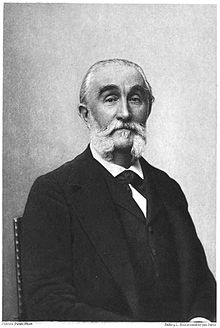Alfred Grandidier
Alfred Grandidier (born December 20, 1836 in Paris , † September 13, 1921 , ibid) was a French naturalist and world traveler. Its official botanical author abbreviation is “ Grandid. ".
to travel
Travels 1857–1860
Coming from a wealthy family, he and his brother Ernest went on a world tour from 1859 to 1860 , which was initially led by the French astronomer Pierre Jules César Janssen . However, he had to return to his home country after six months due to illness.
During this trip the two visited South America (especially the Andes , Peru , Bolivia , Argentina and Brazil ), Alfred Grandidier collected numerous species, which were later analyzed by his brother Ernest.
After that, the brothers parted ways, Ernest went to China , while Alfred (East) toured India and Ceylon . He planned to explore the Tibetan highlands , but was prevented from carrying out his plan by attacks of fever.
Grandidier then traveled to Zanzibar , where he stayed for a long time, partly to relax and partly to organize his extensive scientific collections.
Travels 1865–1870
After a detour to Réunion , he came to Madagascar for the first time in 1865 . The island became Grandidier's largest research project. Before he finally returned to France, he crossed Madagascar three times, covering 2500 km along the coast and more than 3000 km inland.
The most important product of this extensive research trip was the first map of Madagascar. In addition, Grandidier discovered for the first time the remains of the elephant bird ( Aepyornis maximus ), which, due to its size, is considered by today's researchers to be the origin of the Arabian Roch legends.
Publications
Back in France he published the most important natural history work on Madagascar, the " L'Histoire politique, physique et naturelle de Madagascar ", together with the ornithologist Alphonse Milne-Edwards and the zoologist Léon Vaillant . The work appeared in over 30 volumes, and Grandidier did not live to see the last volumes published.
Influence on colonialism
Grandidier's tales and engagement with Madagascar also accelerated colonial France's interest in the island. At the international Congo Conference in 1885, France was assigned to Madagascar as an area of interest; in 1896, after the last ruler Ranavalona III was deposed, France was established . , a protectorate against the will of the indigenous population .
Fonts
- Notes on les mammifères et les oiseaux observés à Madagascar, de 1865 à 1867 . In: Revue zoologique de la Société Cuvierienne (= 2 ). tape 19 , 1867, pp. 353-360 ( biodiversitylibrary.org ).
- Histoire physique, naturelle et politique de Madagascar . Paris (1876)
- Carte de l'île de Madagascar . Paris (1885)
- Over the east coast of Madagascar . (in the Bulletin de la Société de Géographie 1886)
- Histoire de la geographie de la Madagascar . Paris (1893)
- Les voyageurs français à Madagascar pendant les 30 dernières années . (1894)
Memberships
In 1885 he was accepted into the Académie des Sciences .
Honors
Grandidier is the namesake for the Grandidier Channel , a strait off the west coast of the Antarctic Peninsula . In addition, the genus Didierea was named after him.
Web links
- Author entry and list of the described plant names for Alfred Grandidier at the IPNI
Individual evidence
- ^ List of members since 1666: Letter G. Académie des sciences, accessed on November 19, 2019 (French).
| personal data | |
|---|---|
| SURNAME | Grandidier, Alfred |
| BRIEF DESCRIPTION | French naturalist and world traveler |
| DATE OF BIRTH | December 20, 1836 |
| PLACE OF BIRTH | Paris |
| DATE OF DEATH | September 13, 1921 |
| Place of death | Paris |

